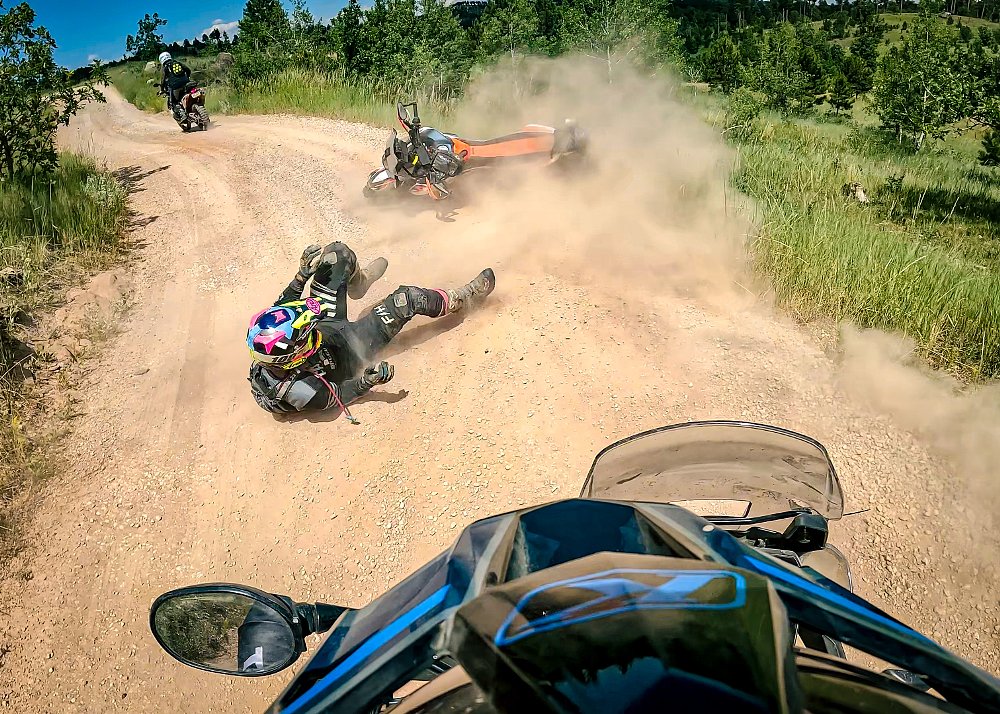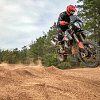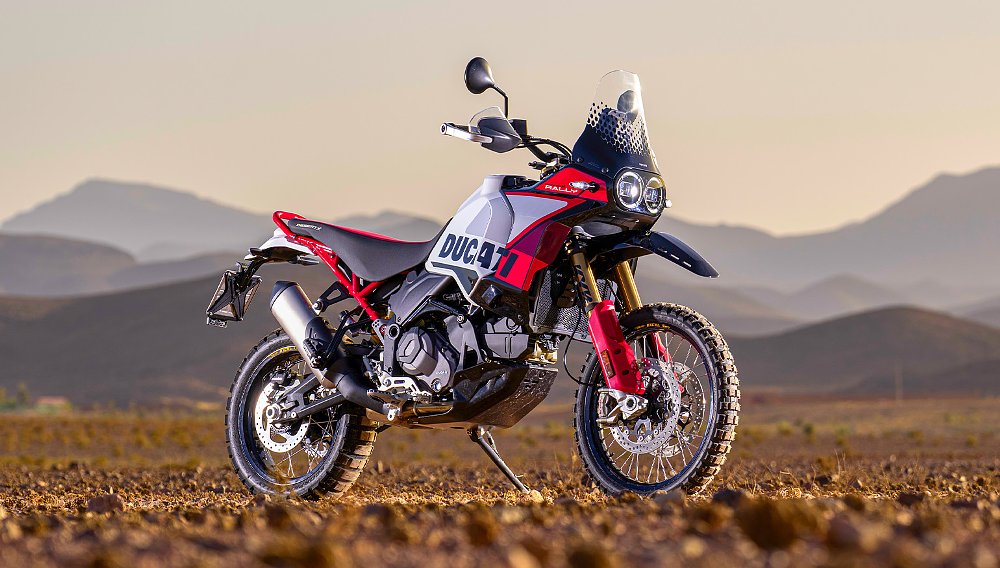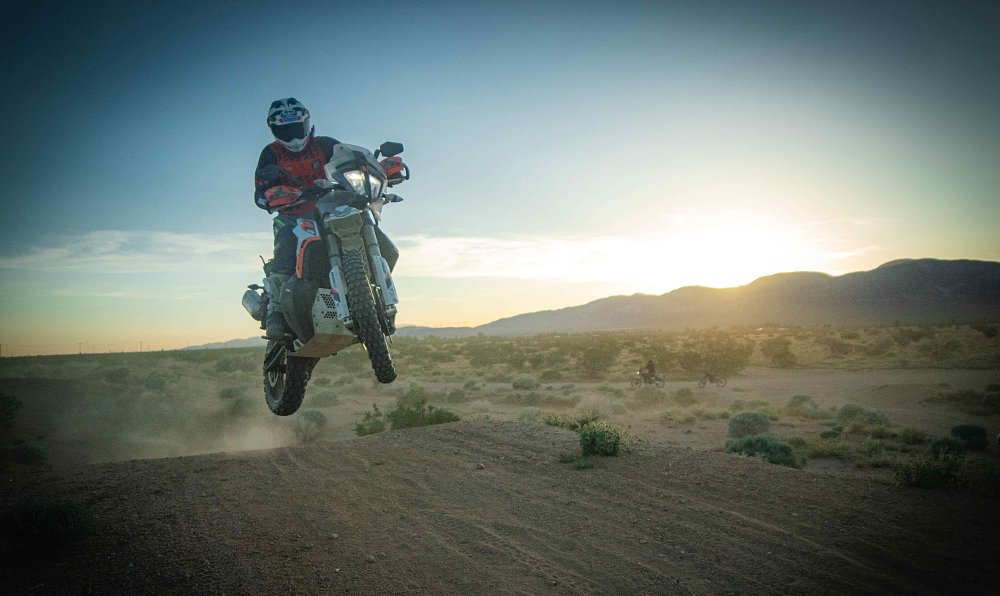It was April 29, 2022, when I sat across the dinner table from Ducati’s CEO, Claudio Domenicali, and recommended a Rally version of the DesertX.
We had just finished a second day of riding the DesertX at the global press launch in Sardinia. For some reason, someone thought it was a smart idea to sit me at the big kids’ table at dinner and the conversation invariably turned to what bikes we personally own. I mentioned that I had just purchased Sally, my 2021 KTM 890 Adventure R Rally. I noted that while the DesertX was a fine machine, a high-performance version, like what KTM had done with its 890 Adventure platform, would probably resonate well with Ducati's audience of enthusiasts.
It was at this point in pitching this article idea to Lance that he held up his hand and narrowed his gaze at me from across my desk and asked, “Are you implying that you think you’re responsible for Ducati bringing this bike to market?” He continued on with something about my hubris knowing no bounds, but honestly, I had stopped listening by that point.
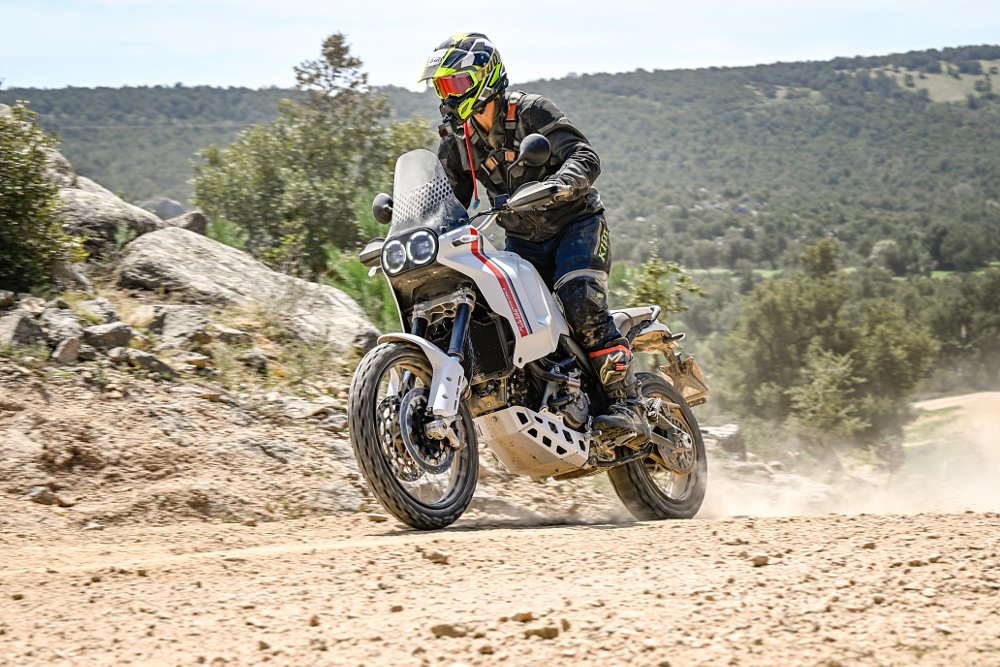
Do I think that I am single-handedly responsible for Ducati to launch a Rally version of their DesertX? Listen, it’s not important what I think. But what I do know is that riders now have two options for up-spec, high-performance, uber off-road-focused middleweight adventure bikes in 2024. KTM is bringing back an 890 Adventure R Rally for the first time since my 2021 version was released. And Ducati has just announced a new Rally variant of their DesertX adventure machine.
As an owner of a 2021 variant of the KTM and as someone who has ridden the base version of both bikes, I thought it would be fun to speculate about the pros and cons of different areas of these two machines. I actually released a similar video a few weeks ago and there were some interesting comments on that video that I’ll also address — in the interest of entertainment, of course.
Suspension
This is the biggest differentiator between these Rally variants and their baseline brethren. Both the KTM and the Ducati get an upgraded, closed-cartridge fork that separates the compression and rebound damping circuits. The rear shocks on both bikes are similarly sophisticated and overall suspension travel and performance look to be upgraded.

Under normal circumstances, it would be nearly impossible to faily judge the suspension's performance based solely on the spec sheet. In this case, however, the suspension on the 2024 KTM Rally is largely the same unit I ripped apart and went in-depth on for our 790 Rally build article, as well as the one that I have on my personal 890 Rally. It gets the upgraded 48 mm WP XPLOR PRO Cone Valve fork with adjustability for preload, compression, and rebound damping, while the rear shock is a WP XPLOR PRO featuring preload, high- and low-speed compression damping, and rebound damping adjustability. Travel is the same for both the front and rear at a whopping 10.63 inches (270 mm).
Regarding the Ducati’s suspension, @bsmukler was able to correct me in the comments section of the video. The original press release for the Ducati had the rear shock listed as a Kayaba with adjustability for preload, compression, and rebound damping and 9.4 inches (240 mm) of travel. However, buried in one of the many press release videos, Ducati noted that the rear shock will also have a split compression circuit for high- and low-speed compression damping. While this might seem inconsequential for the average rider, who never touches their suspension knobs, it drastically improves the tunability of these machines for off-road handling, even for an intermediate rider like myself.
The front suspension on the Ducati is a 48 mm Kayaba inverted fork with adjustability for compression and rebound damping and 9.8 inches (250 mm) of travel. YouTube commenter and Ducati DesertX owner @jackson_foto said he would be surprised if the new bike doesn’t get adjustability for preload, as the stock bike has, but I can find no evidence of that in the press material.

The TL;DR of all of this is that these are incredibly sophisticated suspension setups. @houjous5131 asked me in the comments if I have an opinion regarding whether the KTM’s suspension is worth it. My humble opinion is that the WP suspension on the KTM is the best suspension available on an ADV bike today. It’s the perfect combination of plush and compliant. The bike floats over obstacles off-road yet is planted and provides confidence-inspiring stability on good sport-touring asphalt.
I have yet to ride the new DesertX Rally setup, but the WP Pro components are the suspension to beat and the spec sheet on the Ducati doesn’t have me convinced. If I were a betting man, I’d put my money on the KTM setup coming out on top.
That being said, the DesertX gets a factory Öhlins steering damper. Compare that to the generic piece-of-shit damper on the KTM that does almost nothing (mine completely blew out after 5,000 miles and it’s not rebuildable) and I can’t imagine that the DesertX isn’t going to have a leg up on the KTM in that department. For 890 owners, upgrading to a Scotts damper kit is your best option, but that also means handlebar risers must be used, which is less than ideal for someone like myself who prefers a low handlebar setup. (Even at six feet, three inches tall, I don’t like bar risers.)
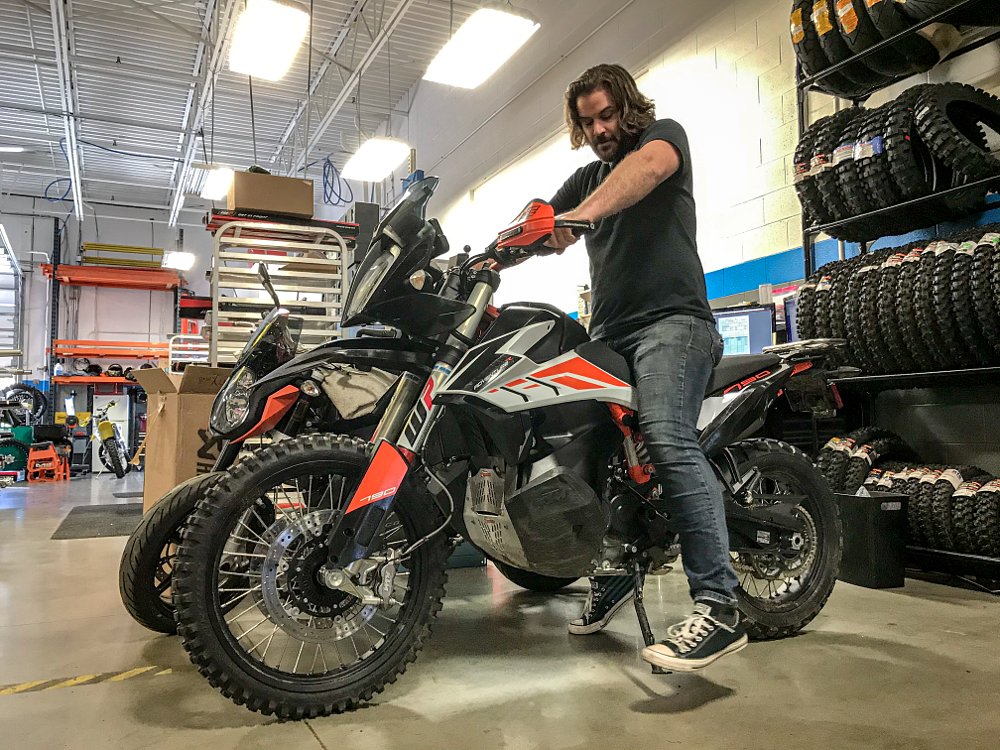
Seat height
With taller suspenders comes taller seat height. While the DesertX Rally’s 35.8-inch seat height sounds tall, it’s got nothing on the 890 Rally’s whopping 37.125-inch seat height (KTM claims 37 inches, but I measured it).
I know that shorter riders are quick to whine about how tall these bikes are. But for those of us on the taller side of the spectrum, I appreciate the seat height on my 890 Rally. It eases the bend angle of my knees and allows me to transition between standing and sitting more easily. Combined with the flat Rally seat, it means I can comfortably ride for hours, moving around to different positions when one grows uncomfortable.
However, KTM owners can shave nearly an inch off their bike by switching to the standard seat (the Rally seat adds about three-quarters of an inch of foam) and even more if they go to a low-seat option. I am sure that Ducati will have similar options for swappable seats. But I don’t know if they will have adjustability to the internals of suspension. One of the things I learned while working with Solid Performance, a KTM and WP Service center, for the initial research around the 790 Rally build article is that the WP Pro Components are completely tunable for overall travel. So if you’re a shorter rider, you can lower the ride height internally for a more approachable seat height while still offering superior performance over the stock suspension. It’s undetermined at this point in time if the Kayaba setup will feature similar adjustability.
So if you’re just looking at base stats out of the box, the Ducati is going to offer a more approachable seat height. But if you’re a shorter rider who is willing to spend a little more time and money dialing in your setup, the KTM appears to be the better option.
Brakes
Coming from my KTM 1090 Adventure R to the 890 Adventure R Rally, I was immediately disappointed by the brakes on the Rally, both the feel and performance. The 890 Rally’s brakes are the same as those on the Adventure R, with dual KTM four-piston calipers up front and a single KTM two-piston caliper at the rear wheel. They’re not bad, but they’re nothing to rave about either.
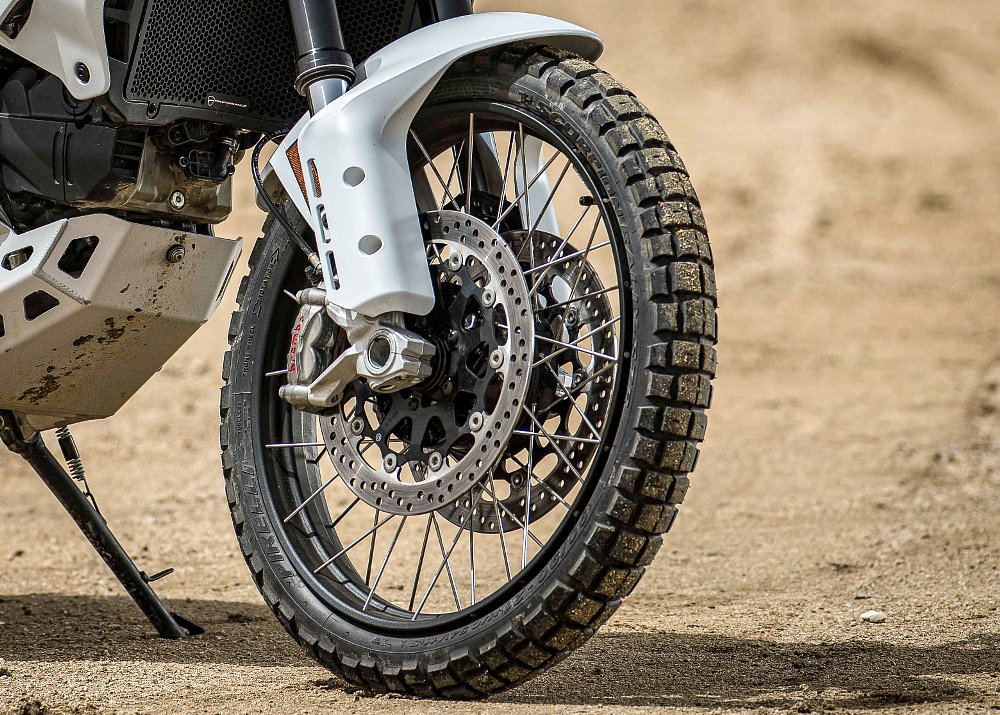
The Ducati’s brakes, however, deserve a standing ovation. With the same braking setup as the base version, dual Brembo M50 monobloc four-piston calipers at the front wheel and a Brembo two-piston caliper at the rear, the DesertX Rally promises superior stopping power and lever feedback. If it weren’t for the sophisticated off-road ABS electronics (featured on both bikes) to offset some of the bite off-road, the brakes would be almost too powerful for off-road use. If real-world performance measures up to spec-sheet promises, Ducati wins this category hands down.
Engine
There is no difference to either bike’s engine over the stock variants, but it’s worth looking at the stats if, for nothing else, to see how closely paired these two powerplants are.
The KTM features a 889 cc, liquid-cooled, eight-valve, parallel twin which is pumping out a claimed 105 horsepower at 8,000 rpm and 74 foot-pounds of torque at 6,500 rpm. The Ducati utilizes the 937 cc, liquid-cooled, eight-valve, 90-degree V-twin previously found in the Monster, Hypermotard, and Multistrada V2. The DesertX claims 110 horsepower at 9,250 rpm and 68 foot-pounds of torque at 6,500 rpm. So if you’re splitting hairs, the KTM has a slight torque advantage and the Ducati gets the win for maximum horsepower.
Even their service intervals are closely matched. KTM recommends regular service at 9,300 miles while Ducati is an even 9,000. And major services like valve checks are recommended at 18,300 for the KTM and 18,000 for the Ducati. Vastly improved from the KTMs and Ducatis of my youth.
The one thing I got wrong in the video was I said that the Ducati’s engine manners were more polite at lower rpm. Upon checking my notes from the launch, I noted that the Ducati’s engine really doesn’t like spinning its pistons below 4,000 rpm. This is the same as the KTM. Neither of these engines likes to be lugged without a little assistance from the clutch.
Fuel capacity
Both bikes are fairly evenly matched in fuel capacity. The 890 Rally features a 5.3-gallon tank and the DesertX Rally gets a 5.5-gallon tank. In the video I mentioned that I normally get between 45 to 48 mpg from my KTM and asked for DesertX owners to drop their mpg estimates in the comments. Shout out to @paulvanhout9695, who said his average is around 45 mpg as well, which means that both bikes should feature a touring range well over 200 miles per tank of gas.
The one difference we didn’t address in the video but did get discussed in the comments was the actual design of the KTM tank over the Ducati. The 890’s tank was designed to lower the overall center of gravity of the bike to help with weight distribution. Coupled with the lower tank guards, the KTM tank design eliminates the need for crash bars, which will cut down on the overall weight of the bike.
The only anecdotal note I have here is that the fancy carbon fiber guards that come standard on the 890 Rally don’t hold up to multiple crashes. They are pretty much single-use only. Couple that with the fact that they are only sold in pairs, and they start getting expensive to replace, especially if you crash as much as I do! My buddy, Nick, recommended trying the covers from Rade Garage over the factory KTM guards and I’m thinking I’ll give those a go the next time around…. Which will be very soon.
Wheels
It looks like both bikes are getting Excel off-road rims. If these are anything like the DID off-road rims that my 2021 bike features, it will allow riders to run a wider range of off-road-focused tires over the stock machines. These also should be a lot sturdier than the more street-focused wheels that come on the base models. The main consideration that folks need to be aware of is that these are tube-type wheels. Tubeless is not an option here, so you need to learn to repair a tube trailside.
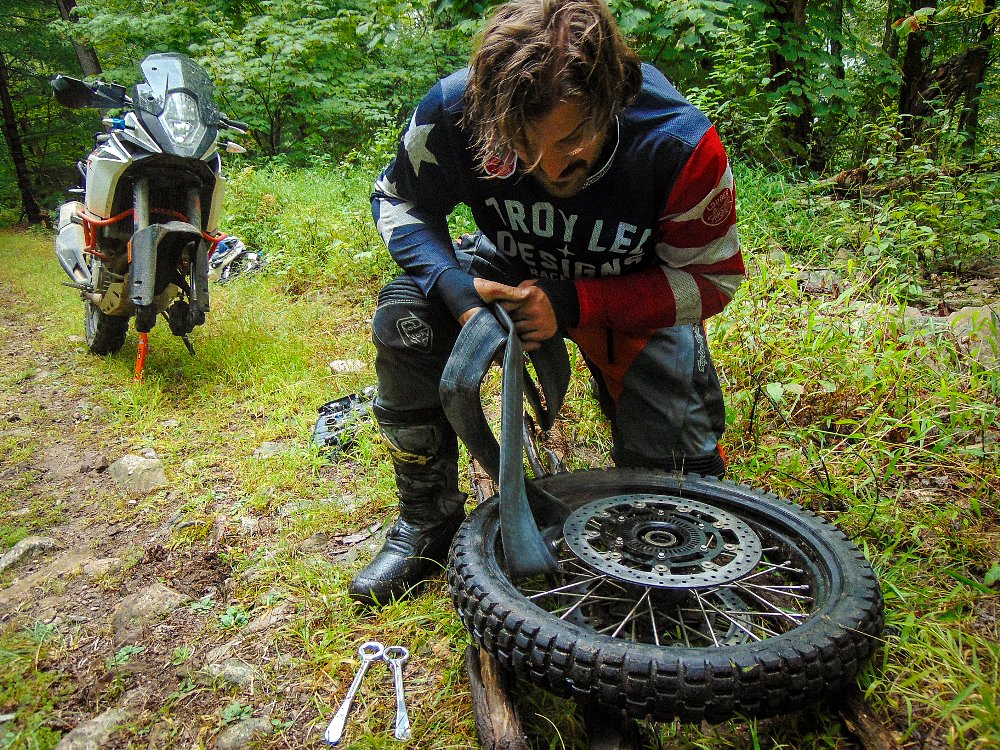
My unpopular opinion is that I think using tubeless rims off-road offers up a false sense of security for people (Zack Courts tells me I’m crazy and that tubeless is the bee's knees). But I’ve seen too many people attending off-road ADV-events running tubeless rims who don’t bother carrying tubes and they don’t know how to install them, and then when they bend a rim they have no reliable options for repairing their flat tire. So kudos to both of these Rallys for running stronger, more dedicated off-road wheels.
Weight
Ducati claims that the DesertX Rally will feature a dry weight of two kilograms more than the stock bike. I’m surprised that no one called out my math conversion error in the video, but that’s roughly 448 pounds. However that number doesn’t include things like gasoline, oil, hand guards, crash bars, etc…). Long story short, I’d be willing to bet that the Ducati DesertX Rally is gonna tip the scales pretty close to 500 pounds by the time you actually get it out on the trail.
On the flip side of that, Zack recently weighed Sally the Rally for an article and Daily Rider episode and my bike tipped the scales at 476 pounds with a full tank of gas, aftermarket skid plate, hand guards, luggage rack, and tubes in her rims (also, Zack didn’t realize it at the time but that also included two spare tubes under the back side covers of the bike). I can’t imagine that the 2024 KTM Rally isn’t going to get the upper hand in this category.
Price
The Ducati DesertX Rally was announced with an MSRP of $22,995, a $5,300 premium over the base price of $17,695. By comparison, the 2024 KTM 890 Adventure R Rally has an MSRP of $21,499, a $6,300 premium over the $15,199 MSRP of the base model. Now, if you think that delta sounds extreme, keep in mind that before I bought my 2021 Rally I did the math and it would have cost about $24,000 to build out to Rally-spec 890 Adventure R after the fact.
The one note that came up in the comments of the video, however, is that 890 Rally production is limited to 700 units worldwide. KTM says all 700 have been reserved and you're welcome to get on their waiting list, but if you don’t already have a reservation on one, there is a good chance that you’ll have to pay a premium if you want to land one in your garage.
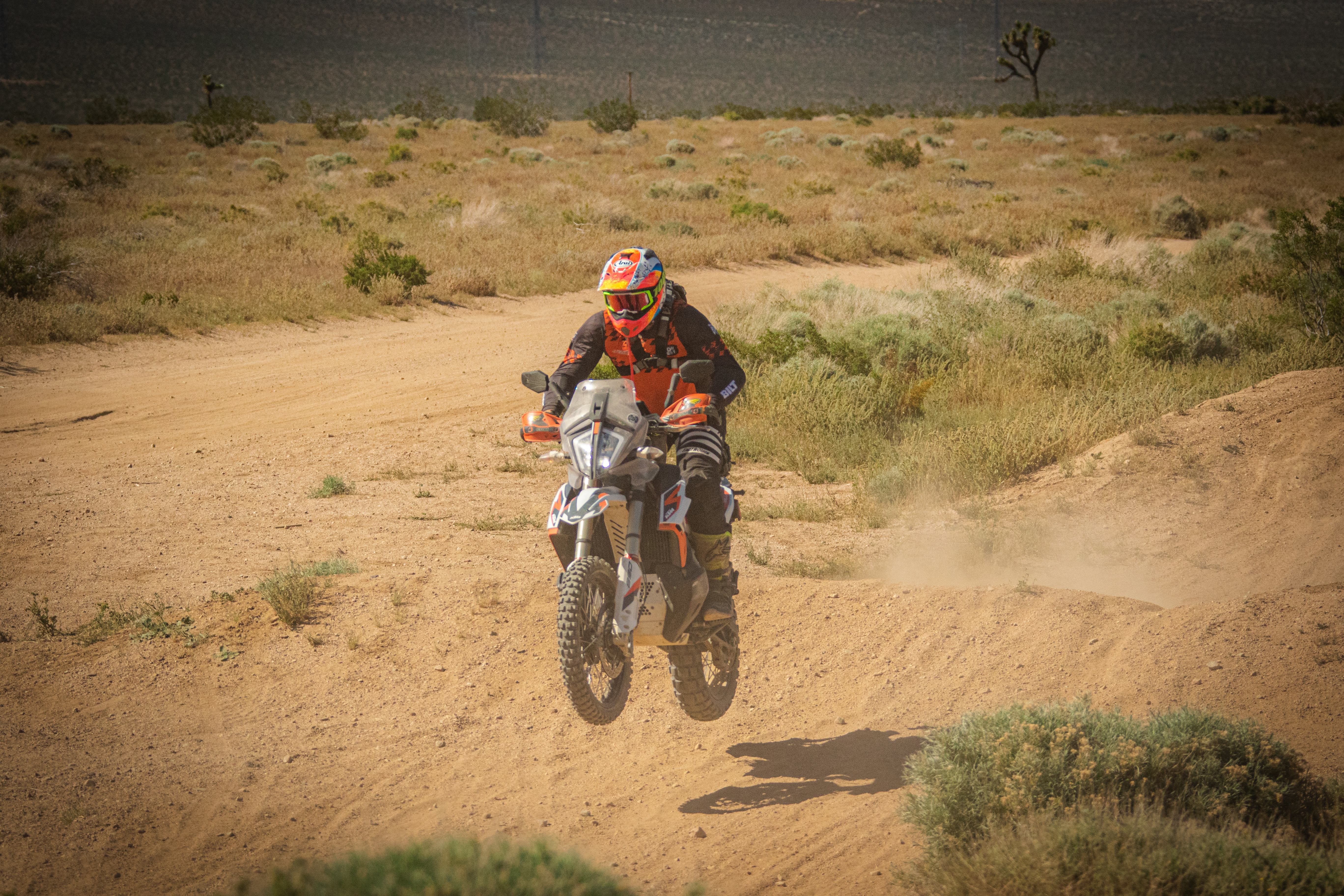
Conclusion
These bikes are not for everyone. The most common reaction is that they’re too expensive. And while I can respect that point of view, they’re motorcycles that represent the pinnacle of performance for those folks who enjoy riding adventure bikes off-road. I fall squarely in that camp and could not be happier with my decision to buy my used 2021 890 Rally when the opportunity presented itself.
When asked directly which of these two I think will be “better,” I say better is subjective. Personally, based on what I’m seeing here, I think the KTM is still going to be the better bike for off-road performance. I don’t think that the Ducati’s suspension and weight distribution will be able to better the 890’s in that regard. That being said, however, I think that the Ducati has a really good shot of being the better “all-around” option of the two. And if it’s the only one available, or if you think it’s better looking than the KTM, then that might make it the better option.
Ultimately, as someone who really enjoys riding ADV bikes off-road, I just think it’s cool that these bikes are being produced. And while I’m not holding out hope that KTM is ever going to loan us a 2024 Rally to compare against the Ducati, it would be cool to be able to ride Ducati Rally one of these days to see how it measures up to Sally. If nothing else, for the purely objective research of being able to tell our readers unbiasedly which one I think is better.
| 2024 Ducati DesertX Rally | 2024 KTM 890 Adventure R Rally | |
|---|---|---|
| Price (MSRP) | $22,995 | $21,499 |
| Engine | 937 cc, liquid-cooled, eight-valve, L-twin | 889 cc, liquid-cooled, eight-valve, parallel twin |
|
Transmission, final drive |
Six-speed, chain | Six-speed, chain |
| Claimed horsepower | 110 @ 9,250 rpm | 105 @ 8,000 |
| Claimed torque | 68 foot-pounds @ 6,500 rpm | 74 foot-pounds @ 6,500 rpm |
| Frame | Tubular steel trellis | Steel alloy |
| Front suspension | Kayaba 48 mm inverted fork, adjustable for compression and rebound damping; 9.8 inches of travel | 48 mm WP XPLOR PRO 7548 fork, adjustable for preload, compression, and rebound damping; 10.63 inches of travel |
| Rear suspension | Kayaba shock, adjustable for preload, compression, and rebound damping; 9.4 inches of travel | WP XPLOR PRO 6746, adjustable for preload, high- and low-speed compression damping, and rebound damping; 10.63 inches of travel |
| Front brake | Dual Brembo M50 four-piston calipers, 320 mm discs with cornering ABS | Dual KTM four-piston calipers, 320 mm discs with cornering ABS |
| Rear brake | Brembo two-piston caliper, 265 mm disc with cornering ABS | KTM two-piston caliper, 260 mm disc with cornering ABS |
| Rake, trail | 27.6 degrees, 4.8 inches | 26.2 degrees, 4.35 inches |
| Wheelbase | 64 inches | 60.2 inches |
| Seat height | 35.8 inches | 37 inches |
| Fuel capacity | 5.54 gallons | 5.3 gallons |
| Tires | Pirelli Scorpion Rally STR, 90/90-21 front, 150/70R18 rear | Mitas E-07 90/90-21 front, 150/70-18 rear |
| Claimed weight | N/A | N/A |
| Available | March 2024 | February to May 2024 |
| Warranty | 24 months | 12 months |
| More info | ducati.com | ktm.com |

 Membership
Membership


